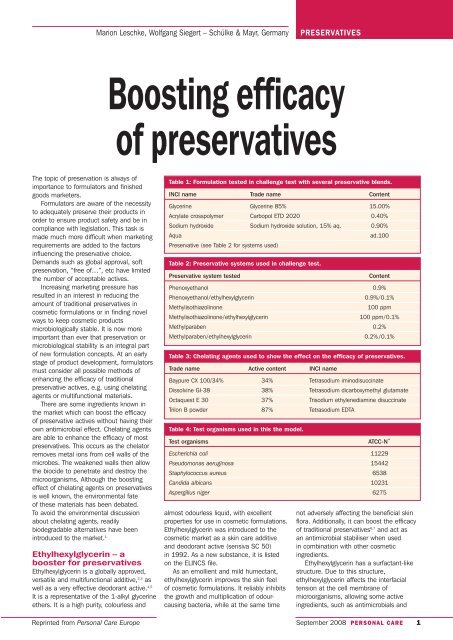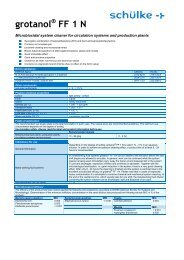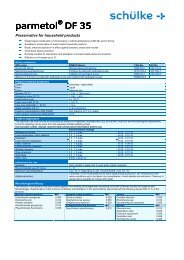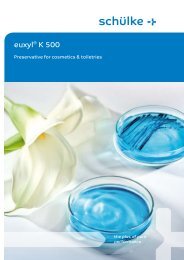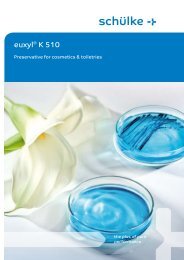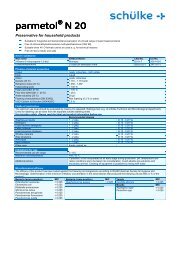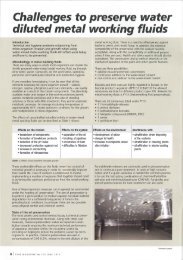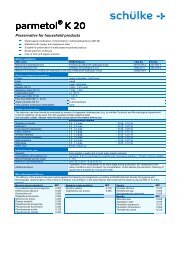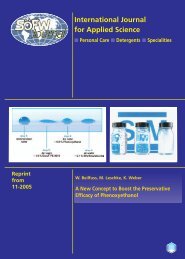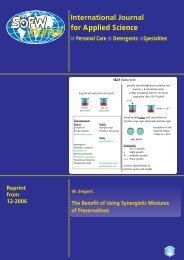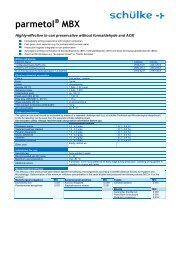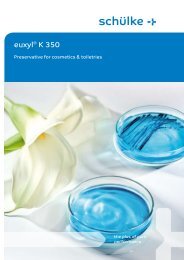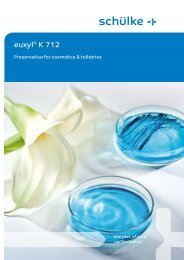Boosting efficacy of preservatives - ResearchGate
Boosting efficacy of preservatives - ResearchGate
Boosting efficacy of preservatives - ResearchGate
Create successful ePaper yourself
Turn your PDF publications into a flip-book with our unique Google optimized e-Paper software.
Marion Leschke, Wolfgang Siegert – Schülke & Mayr, Germany<br />
PRESERVATIVES<br />
<strong>Boosting</strong> <strong>efficacy</strong><br />
<strong>of</strong> <strong>preservatives</strong><br />
The topic <strong>of</strong> preservation is always <strong>of</strong><br />
importance to formulators and finished<br />
goods marketers.<br />
Formulators are aware <strong>of</strong> the necessity<br />
to adequately preserve their products in<br />
order to ensure product safety and be in<br />
compliance with legislation. This task is<br />
made much more difficult when marketing<br />
requirements are added to the factors<br />
influencing the preservative choice.<br />
Demands such as global approval, s<strong>of</strong>t<br />
preservation, “free <strong>of</strong>…”, etc have limited<br />
the number <strong>of</strong> acceptable actives.<br />
Increasing marketing pressure has<br />
resulted in an interest in reducing the<br />
amount <strong>of</strong> traditional <strong>preservatives</strong> in<br />
cosmetic formulations or in finding novel<br />
ways to keep cosmetic products<br />
microbiologically stable. It is now more<br />
important than ever that preservation or<br />
microbiological stability is an integral part<br />
<strong>of</strong> new formulation concepts. At an early<br />
stage <strong>of</strong> product development, formulators<br />
must consider all possible methods <strong>of</strong><br />
enhancing the <strong>efficacy</strong> <strong>of</strong> traditional<br />
preservative actives, e.g. using chelating<br />
agents or multifunctional materials.<br />
There are some ingredients known in<br />
the market which can boost the <strong>efficacy</strong><br />
<strong>of</strong> preservative actives without having their<br />
own antimicrobial effect. Chelating agents<br />
are able to enhance the <strong>efficacy</strong> <strong>of</strong> most<br />
<strong>preservatives</strong>. This occurs as the chelator<br />
removes metal ions from cell walls <strong>of</strong> the<br />
microbes. The weakened walls then allow<br />
the biocide to penetrate and destroy the<br />
microorganisms. Although the boosting<br />
effect <strong>of</strong> chelating agents on <strong>preservatives</strong><br />
is well known, the environmental fate<br />
<strong>of</strong> these materials has been debated.<br />
To avoid the environmental discussion<br />
about chelating agents, readily<br />
biodegradable alternatives have been<br />
introduced to the market. 1<br />
Ethylhexylglycerin – a<br />
booster for <strong>preservatives</strong><br />
Ethylhexylglycerin is a globally approved,<br />
versatile and multifunctional additive, 2,3 as<br />
well as a very effective deodorant active. 4,5<br />
It is a representative <strong>of</strong> the 1-alkyl glycerine<br />
ethers. It is a high purity, colourless and<br />
Reprinted from Personal Care Europe<br />
Table 1: Formulation tested in challenge test with several preservative blends.<br />
INCI name Trade name Content<br />
Glycerine Glycerine 85% 15.00%<br />
Acrylate crosspolymer Carbopol ETD 2020 0.40%<br />
Sodium hydroxide Sodium hydroxide solution, 15% aq. 0.90%<br />
Aqua<br />
ad.100<br />
Preservative (see Table 2 for systems used)<br />
Table 2: Preservative systems used in challenge test.<br />
Preservative system tested<br />
almost odourless liquid, with excellent<br />
properties for use in cosmetic formulations.<br />
Ethylhexylglycerin was introduced to the<br />
cosmetic market as a skin care additive<br />
and deodorant active (sensiva SC 50)<br />
in 1992. As a new substance, it is listed<br />
on the ELINCS file.<br />
As an emollient and mild humectant,<br />
ethylhexylglycerin improves the skin feel<br />
<strong>of</strong> cosmetic formulations. It reliably inhibits<br />
the growth and multiplication <strong>of</strong> odourcausing<br />
bacteria, while at the same time<br />
Content<br />
Phenoxyethanol 0.9%<br />
Phenoxyethanol/ethylhexylglycerin 0.9%/0.1%<br />
Methylisothiazolinone<br />
100 ppm<br />
Methylisothiazolinone/ethylhexylglycerin<br />
100 ppm/0.1%<br />
Methylparaben 0.2%<br />
Methylparaben/ethylhexylglycerin 0.2% /0.1%<br />
Table 3: Chelating agents used to show the effect on the <strong>efficacy</strong> <strong>of</strong> <strong>preservatives</strong>.<br />
Trade name Active content INCI name<br />
Baypure CX 100/34% 34% Tetrasodium iminodisuccinate<br />
Dissolvine GI-38 38% Tetrasodium dicarboxymethyl glutamate<br />
Octaquest E 30 37% Trisodium ethylenediamine disuccinate<br />
Trilon B powder 87% Tetrasodium EDTA<br />
Table 4: Test organisms used in this the model.<br />
Test organisms<br />
ATCC-N˚<br />
Escherichia coli 11229<br />
Pseudomonas aeruginosa 15442<br />
Staphylococcus aureus 6538<br />
Candida albicans 10231<br />
Aspergillus niger 6275<br />
not adversely affecting the beneficial skin<br />
flora. Additionally, it can boost the <strong>efficacy</strong><br />
<strong>of</strong> traditional <strong>preservatives</strong> 6,7 and act as<br />
an antimicrobial stabiliser when used<br />
in combination with other cosmetic<br />
ingredients.<br />
Ethylhexylglycerin has a surfactant-like<br />
structure. Due to this structure,<br />
ethylhexylglycerin affects the interfacial<br />
tension at the cell membrane <strong>of</strong><br />
microorganisms, allowing some active<br />
ingredients, such as antimicrobials and<br />
September 2008 PERSONAL CARE 1
PRESERVATIVES<br />
preservative actives, to penetrate more<br />
effectively.<br />
In order to prove the preservative<br />
boosting effect <strong>of</strong> ethylhexylglycerin,<br />
challenge tests have been carried out on<br />
a carbomer gel formulation. Table 1 shows<br />
the tested formulation. Phenoxyethanol,<br />
methylisothiazolinone and methylparaben<br />
have been used as preservative actives<br />
(Table 2).<br />
Method<br />
Challenge tests have been performed<br />
according to the Schülke KoKo test<br />
method. 8,9 The Schülke KoKo test is a<br />
repeated challenge test designed and<br />
validated by Schülke. A mixed suspension<br />
<strong>of</strong> Gram-positive and Gram-negative<br />
bacteria, yeasts and moulds is used for<br />
six inoculations at weekly intervals. Parallel<br />
to each inoculation a sample <strong>of</strong> the tested<br />
product is streaked out onto nutrient<br />
media, incubated and evaluated semiquantitatively.<br />
The longer the time before<br />
the occurrence <strong>of</strong> the first microbial growth,<br />
the more effective is the preservative.<br />
Experience has shown that a well-preserved<br />
product should remain growth-free for six<br />
inoculation cycles to ensure the shelf-life<br />
required in practice (30 months in the<br />
original packaging) (Fig. 1).<br />
Results<br />
Challenge test results with the single<br />
preservative actives on one hand and<br />
the combination <strong>of</strong> the single actives with<br />
ethylhexylglycerin on the other are listed in<br />
Figure 2. The results impressively show the<br />
boosting effect <strong>of</strong> 0.1 % ethylhexylglycerin<br />
on the preservation effect <strong>of</strong><br />
phenoxyethanol, methylisothiazolinone and<br />
methylparaben. While the single actives fail<br />
after 2 inoculation cycles, the addition <strong>of</strong><br />
ethylhexylglycerin increased the <strong>efficacy</strong><br />
<strong>of</strong> phenoxyethanol, methylisothiazolinone<br />
and methylparaben sufficiently to pass<br />
the KoKo test.<br />
The combination <strong>of</strong> phenoxyethanol<br />
and ethylhexylglycerin is well-described in<br />
literature. 6,7 It is protected by patent and<br />
commercially available under the trade<br />
name euxyl PE 9010. The combination<br />
with methylisothiazolinone is also protected<br />
by patent and supplied in the market<br />
as euxyl K 220.<br />
<strong>Boosting</strong> preservative<br />
<strong>efficacy</strong> with chelating<br />
agents<br />
While in the past there were discussions<br />
about the environmental effect <strong>of</strong> chelating<br />
agents, new readily biodegradable<br />
alternatives have been developed and<br />
tested under reproducible conditions.<br />
Several examples <strong>of</strong> this new generation<br />
<strong>of</strong> chelating agents have been tested vs<br />
KoKo – Test SM 021<br />
25 g <strong>of</strong> each material to be tested<br />
Without<br />
preservative<br />
With x%<br />
preservative<br />
2 days exposure time<br />
streak (see below) as sterility control<br />
Germ spectrum<br />
Bacteria: Moulds: Yeasts:<br />
Gram-positive Aspergillus niger Candida albicans<br />
Kocuria rhizophila<br />
Pencillium funiculosum<br />
Staphylococcus aureus<br />
Gram-negative<br />
Enterobacter gergoviae<br />
Escherichia coli<br />
Klebsiella pneumoniae<br />
Pseudomonas aeruginosa<br />
Pseudomonas fluorescens<br />
Pseudomonas putida<br />
Periodic microbiological preservation test<br />
Weekly inoculation with 0.1 ml mixed suspension<br />
6 weeks = 6 inoculation cycles (titre 10 8 – 10 9 cfu/ml)<br />
Streak weekly before each inoculation on CS-agar and SA-agar<br />
Incubation <strong>of</strong> the<br />
nutrient media:<br />
3 days at +25°C<br />
Storage at +25˚C<br />
Figure 1: Evaluation <strong>of</strong> the microbial stability <strong>of</strong> cosmetic formulations with the Schülke KoKo test.<br />
traditional tetrasodium EDTA regarding their<br />
ability to increase the <strong>efficacy</strong> <strong>of</strong> cosmetic<br />
<strong>preservatives</strong>. For the following series,<br />
euxyl PE 9010 has been chosen as the<br />
test preservative.<br />
To obtain a clear differentiation<br />
between the preservative with and without<br />
complexing agent, the use concentration<br />
<strong>of</strong> the preservative was selected at<br />
the lowest effective concentration.<br />
For the combination phenoxyethanol/<br />
ethylhexylglycerin (euxyl PE 9010) in water<br />
this is 0.75 %. Different chelating agents<br />
dosed at 0.1% and 0.2% active material<br />
have been tested (Table 3).<br />
Method<br />
Dilutions <strong>of</strong> the preservative and<br />
combinations <strong>of</strong> the preservative/booster<br />
are prepared using sterile hard water<br />
according to the European standard<br />
for testing chemical disinfectants and<br />
antiseptics. 10 Worked with are 50 ml<br />
quantities <strong>of</strong> the end solutions and these<br />
quantities are each inoculated with<br />
Agar plates<br />
Assessment:<br />
– Free <strong>of</strong> growth<br />
+ Slight growth<br />
++ Moderate growth<br />
+++ Heavy growth<br />
0.5 ml microorganism suspension (initial<br />
microorganism count approx 10 8 cfu/ml)<br />
and stirred. Table 4 shows the test<br />
organisms used.<br />
These solutions are streaked out onto<br />
tryptone soya agar or sabouraud-dextrose<br />
4% agar after 1, 3, 6, and 24 hours.<br />
The cultures are incubated for 48 hours<br />
at 37˚C, except for Aspergillus niger, which<br />
is incubated for 72 hours at 25˚C–27˚C.<br />
The evaluation is made on the basis <strong>of</strong><br />
semi-quantitative assessment <strong>of</strong> the<br />
microbial growth <strong>of</strong> the streaks.<br />
Due to the alkalinity <strong>of</strong> the complexing<br />
agents, the final solution is adjusted to pH<br />
7.0. Hydrochloric acid (HCl) is chosen as<br />
inorganic acid and citric acid as organic<br />
alpha-hydroxy acid. The citrates formed<br />
can support the chelating effect.<br />
Results<br />
The graphs in Figure 3 show the boosting<br />
effect <strong>of</strong> the chelating agents on<br />
euxyl PE 9010.<br />
All <strong>of</strong> the complexing agents used in this<br />
2 PERSONAL CARE September 2008
PRESERVATIVES<br />
Carbomer gel<br />
Inoculation cycles<br />
0 1 2 3 4 5 6<br />
Without preservation – +++ +++ . /.<br />
B, M B, M<br />
+ 0.1% ethylhexylglycerin – +++ +++ . /.<br />
M<br />
B, M<br />
+ 0.9% phenoxyethanol – +++ +++ . /.<br />
B<br />
B, Y<br />
+ 0.9% phenoxyethanol – – – – – – –<br />
+ 0.1% ethylhexylglycerin<br />
+ 100 ppm methylisothiazolinone – +++ +++ . /.<br />
M<br />
B, M<br />
+ 100 ppm methylisothiazolinone – – – – – – –<br />
+ 0.1% ethylhexylglycerin<br />
+ 0.2% methylparaben – +++ +++ . /.<br />
B, Y B, Y<br />
+ 0.2% methylparaben – – – – – – –<br />
+ 0.1% ethylhexylglycerin<br />
Legend: 0 = Sterility control – = Free <strong>of</strong> microbial growth<br />
B = Bacteria + = Slight growth<br />
M = Moulds ++ = Moderate growth<br />
Sp = Spore-forming bacteria +++= Massive growth<br />
Y = Yeasts<br />
Figure 2: Schülke KoKo test results showing the preservative-boosting effect <strong>of</strong> ethylhexylglycerin.<br />
test exhibit a boosting effect on the<br />
preservative. Noticeably, tetrasodium<br />
dicarboxymethyl glutamate in combination<br />
with citric acid gives a substantially better<br />
effect than can be achieved with any <strong>of</strong><br />
the other combinations tested. Particularly<br />
unexpected is the good effect <strong>of</strong><br />
tetrasodium dicarboxymethyl glutamate in<br />
combination with citric acid against fungi.<br />
Practical experience<br />
In order to transfer these results into<br />
practical cosmetic systems, additional<br />
Schülke KoKo tests have been conducted.<br />
One example is presented in Figure 4.<br />
A sun care product has been tested<br />
containing 1.0% euxyl PE 9010 with and<br />
without the addition <strong>of</strong> a chelating agent.<br />
In this case 0.2% disodium EDTA<br />
(Trilon BD) was used.<br />
The results are very clear. While the<br />
sun care product with euxyl PE 9010 alone<br />
failed in the Schülke KoKo test, after<br />
addition <strong>of</strong> the chelating agent the product<br />
was well preserved for 6 inoculation cycles.<br />
Conclusion<br />
Ongoing public discussions about several<br />
preservative actives and the increasing<br />
demands <strong>of</strong> marketing make it now more<br />
important than ever to find ways to boost<br />
the <strong>efficacy</strong> <strong>of</strong> traditional preservative<br />
actives.<br />
Ethylhexylglycerin has been proven<br />
to increase the <strong>efficacy</strong> <strong>of</strong> preservative<br />
actives such as phenoxyethanol,<br />
methylisothiazolinone or methylparaben.<br />
Furthermore, it has been shown that<br />
chelating agents can have an additional<br />
boosting effect on preservative/<br />
ethylhexylglycerin blends.<br />
This innovative combination <strong>of</strong><br />
ethylhexylglycerin and chelating agent may<br />
help to reduce the quantity <strong>of</strong> <strong>preservatives</strong><br />
required to adequately protect cosmetic<br />
formulations.<br />
P C<br />
References<br />
1 Steinberg D.C. Preservatives for Cosmetics,<br />
Allured Publishing Corporation, 2006.<br />
2 Eggensperger H. Multiaktive Wirkst<strong>of</strong>fe für<br />
Kosmetika, Verlag für chemische Industrie H.<br />
Ziolkowsky GmbH Augsburg, 1995,<br />
141–159.<br />
3 Beilfuß W., Siegert W. Cossma, 2003, 6,<br />
54–55.<br />
4 Beilfuß W. SÖFW Journal, 1998, 6, 360–366<br />
(German).<br />
5 Fishman H.M. Happi, 2005, Vol. 42, No. 2,<br />
part 1 <strong>of</strong> 2, 35.<br />
6 Beilfuß W., Weber K., Leschke M. SÖFW<br />
Journal, 2005, 11, 30–36 (English).<br />
7 Leschke M., Wüstermann S. SÖFW Journal,<br />
2006, 4, 78–82 (English).<br />
8 Weber K., Siebert J. SÖFW Journal, 2003, 6,<br />
44–50 (English); 48–55 (German).<br />
9 Siegert W. Cosmetic Science Technology,<br />
2005, 189–195.<br />
10 European Standard (CEN), Chemical<br />
disinfectants and antiseptics.<br />
Natural sunscreen SPF 30<br />
Inoculation cycles<br />
0 1 2 3 4 5 6<br />
Without preservation – +++ +++ . /.<br />
B, Y, M B, Y, M<br />
+ 1.0% euxyl PE 9010 – +++ +++ . /.<br />
B, Y, M B, Y, M<br />
+ 1.0% euxyl PE 9010 – – – – – – –<br />
+ 0.2% disodium EDTA<br />
Legend: 0 = Sterility control – = Free <strong>of</strong> microbial growth<br />
B = Bacteria + = Slight growth<br />
M = Moulds ++ = Moderate growth<br />
Sp = Spore-forming bacteria +++= Massive growth<br />
Y = Yeasts<br />
Figure 4: Sun care product preserved with euxyl PE 9010, with and without disodium EDTA.<br />
September 2008 PERSONAL CARE 3
PRESERVATIVES<br />
6<br />
Without preservative (growth control)<br />
Citric acid HCI<br />
6<br />
0.75% Euxyl PE 9010 (without complexing agent)<br />
Citric acid HCI<br />
Log germ count reduction<br />
5<br />
4<br />
3<br />
2<br />
1<br />
0<br />
6<br />
1 3 6 24 1 3 6 24 1 3 6 24 1 3 6 24 1 3 6 24 hrs<br />
E. coli Ps. Staph. Candida A. niger<br />
aeruginosa aureus albicans<br />
0.75% Euxyl PE 9010<br />
+0.1% Tetrasodium EDTA<br />
Citric acid HCI<br />
Log germ count reduction<br />
5<br />
4<br />
3<br />
2<br />
1<br />
0<br />
6<br />
1 3 6 24 1 3 6 24 1 3 6 24 1 3 6 24 1 3 6 24 hrs<br />
E. coli Ps. Staph. Candida A. niger<br />
aeruginosa aureus albicans<br />
0.75% Euxyl PE 9010<br />
+0.2% Tetrasodium EDTA<br />
Citric acid<br />
HCI<br />
euxyl ®<br />
optimum<br />
preservation<br />
Log germ count reduction<br />
5<br />
4<br />
3<br />
2<br />
1<br />
Log germ count reduction<br />
5<br />
4<br />
3<br />
2<br />
1<br />
0<br />
1 3 6 24 1 3 6 24 1 3 6 24 1 3 6 24 1 3 6 24 hrs<br />
E. coli Ps. Staph. Candida A. niger<br />
aeruginosa aureus albicans<br />
0<br />
1 3 6 24 1 3 6 24 1 3 6 24 1 3 6 24 1 3 6 24 hrs<br />
E. coli Ps. Staph. Candida A. niger<br />
aeruginosa aureus albicans<br />
6<br />
0.75% Euxyl PE 9010<br />
+0.1% Tetrasodium dicarboxymethyl glutamate<br />
Citric acid HCI<br />
6<br />
0.75% Euxyl PE 9010<br />
+0.2% Tetrasodium dicarboxymethyl glutamate<br />
Citric acid HCI<br />
Log germ count reduction<br />
5<br />
4<br />
3<br />
2<br />
1<br />
Log germ count reduction<br />
5<br />
4<br />
3<br />
2<br />
1<br />
0<br />
6<br />
1 3 6 24 1 3 6 24 1 3 6 24 1 3 6 24 1 3 6 24 hrs<br />
E. coli Ps. Staph. Candida A. niger<br />
aeruginosa aureus albicans<br />
0.75% Euxyl PE 9010<br />
+0.1% Tetrasodium iminodisuccinate<br />
Citric acid HCI<br />
0<br />
6<br />
1 3 6 24 1 3 6 24 1 3 6 24 1 3 6 24 1 3 6 24 hrs<br />
E. coli Ps. Staph. Candida A. niger<br />
aeruginosa aureus albicans<br />
0.75% Euxyl PE 9010<br />
+0.2% Tetrasodium iminodisuccinate<br />
Citric acid HCI<br />
euxyl® is a family <strong>of</strong> multi-component<br />
preservative systems that makes formulating<br />
simpler.<br />
Log germ count reduction<br />
5<br />
4<br />
3<br />
2<br />
1<br />
0<br />
6<br />
1 3 6 24 1 3 6 24 1 3 6 24 1 3 6 24 1 3 6 24 hrs<br />
E. coli Ps. Staph. Candida A. niger<br />
aeruginosa aureus albicans<br />
0.75% Euxyl PE 9010<br />
+0.1% Tetrasodium ethylenediamine disuccinate<br />
Citric acid HCI<br />
Log germ count reduction<br />
5<br />
4<br />
3<br />
2<br />
1<br />
0<br />
6<br />
1 3 6 24 1 3 6 24 1 3 6 24 1 3 6 24 1 3 6 24 hrs<br />
E. coli Ps. Staph. Candida A. niger<br />
aeruginosa aureus albicans<br />
0.75% Euxyl PE 9010<br />
+0.2% Tetrasodium ethylenediamine disuccinate<br />
Citric acid HCI<br />
We have researched optimum blends<br />
with a broad spectrum <strong>of</strong> <strong>efficacy</strong><br />
against bacteria, yeasts and moulds.<br />
With a wide variety <strong>of</strong> easy-handling<br />
liquid blends to choose from, there is<br />
an euxyl® product to meet almost any<br />
preservation need.<br />
Let us make preservation<br />
simple for you.<br />
Log germ count reduction<br />
5<br />
4<br />
3<br />
2<br />
1<br />
0<br />
1 3 6 24 1 3 6 24 1 3 6 24 1 3 6 24 1 3 6 24 hrs<br />
E. coli Ps. Staph. Candida A. niger<br />
aeruginosa aureus albicans<br />
Figure 3: Test results showing the boosting effect <strong>of</strong> different chelating agents on the<br />
antimicrobial <strong>efficacy</strong> <strong>of</strong> euxyl PE 9010.<br />
Log germ count reduction<br />
5<br />
4<br />
3<br />
2<br />
1<br />
0<br />
1 3 6 24 1 3 6 24 1 3 6 24 1 3 6 24 1 3 6 24 hrs<br />
E. coli Ps. Staph. Candida A. niger<br />
aeruginosa aureus albicans<br />
Schülke & Mayr GmbH<br />
22840 Norderstedt<br />
Tel.: (+49) 40 - 521 00 - 0<br />
www.schuelke.com<br />
sai@schuelke.com<br />
4 PERSONAL CARE September 2008


